Abstract
This paper considers the optimized packing of different spheres into a given spherical container under non-standard placement conditions. A sphere is considered placed in the container if at least a certain part of the sphere is in the container. Spheres are allowed to overlap with each other according to predefined parameters. Ratio conditions are introduced to establish correspondence between the number of packed spheres of different radii. The packing aims to maximize the total number of packed spheres subject to ratio, partial overlapping and quasi-containment conditions. A nonlinear mixed-integer optimization model is proposed for this ratio quasi-packing problem. A heuristic algorithm is developed that reduces the original problem to a sequence of continuous open dimension problems for quasi-packing scaled spheres. Computational results for finding global solutions for small instances and good feasible solutions for large instances are provided.
Keywords:
sphere packing; spherical container; ratio condition; partial overlapping; quasi-containment; optimization MSC:
52C17; 05B40; 90C26; 90C59
1. Introduction
In classical sphere packing problems, non-overlapping spherical objects must be placed completely inside a container [1]. These conditions, referred to as non-overlapping and containment, form key constraints in the corresponding optimized packing problems. In these problems, either the container is fixed and the total volume of packed spheres is maximized, or the spheres are fixed and the smallest container is constructed to fit all the spheres. Sphere packing problems are well studied and arise in biology [2,3,4,5], medicine [6,7], physics [8,9,10,11] and engineering [12,13,14,15,16,17], to mention a few.
Numerical methods to solve optimized sphere packing problems can be divided into exact and approximate approaches. Exact solution techniques are typically based on corresponding nonlinear programming models and use global optimization schemes (e.g., branch and bound) for their solution [18]. This approach is efficient for relatively small problem instances. For larger instances, exact schemes are frequently combined with heuristics [19]. Many combined approaches are based on nonlinear optimization models and then use exact or heuristic local techniques [19,20,21,22] to obtain reasonable solutions. Approximation of the container by a finite grid results in a binary assignment problem for centers of spheres to nodes of the grid [23,24,25,26]. Many approaches [27,28,29,30,31,32,33] combine several techniques.
This paper is focused on non-standard packing problems where either non-overlapping or containment or both conditions are allowed to be violated. In what follows, these problems are referred to as quasi-packing. Allowing a controlled overlap is frequently used in modeling packing problems in natural sciences since soft spheres can be modeled as hard spheres with a limited overlap. Examples are the spatial organization of chromosomes in the cell nucleus [2,34], the spatial organization of neurons [3,4] or the arrangement of ganglion cell receptive fields on the retinal surface [35,36]. From a mathematical point of view, introducing a limited overlap may be considered as an intermediate case between sphere packing and sphere covering [37]. In sphere packing, the main objective is to achieve the densest layout, i.e., layout where the spheres fill the maximal possible space in the container. In contrast, sphere covering corresponds to a layout of spheres that covers the whole space. In this case, overlapping is not only allowed but inevitable. Our interest in packing with overlap is motivated by modeling porous media under pressure [38,39,40]. These problems arise frequently in oil and gas extracting industries [41,42,43]. Elements of porous media can be deformed by external force. This corresponds to the partial overlapping of spheres.
In quasi-packing, a sphere is considered placed in the container if at least a certain part of the sphere is in the container. This relaxation of classical containment arises, e.g., in modeling a distribution of spherical particles in porous media [44,45]. The porous material can be analyzed experimentally by extracting a volumetric sample (container) for further investigation or by mathematical simulation of the material structure in the sample. Since some spheres are cut off in the extraction process, only parts of them may remain in the sample. Correspondingly, the mathematical model should allow spheres that are not entirely placed in the container.
In this paper, optimized quasi-packing of different spheres in a spherical container is introduced. The objective is to maximize the total number of spheres placed in the container subject to quasi-packing constraints. It is assumed that a certain correspondence between the number of packed spheres of different radii must be kept. Ratio conditions are introduced to establish lower and upper bounds for the relative impact (percentage) of the number of spheres of a certain radius to the total number of spheres.
The main contributions of this paper are as follows:
- (1)
- A novel class of sphere packing in a spherical container with partial overlapping, quasi-containment and ratio conditions.
- (2)
- A mixed-integer nonlinear programming model for the ratio quasi-packing of spheres.
- (3)
- A heuristic for large problem instances consisting of finding feasible starting points in an open dimension continuous optimization problem to obtain reasonable feasible solutions.
- (4)
- Numerical experiments for small problem instances with exact solutions obtained using the global solver BARON.
- (5)
- Numerical experiments for larger problem instances with good feasible solutions obtained by the heuristic using the local solver IPOPT for open dimension problems.
The paper is organized as follows. Section 2 presents the ratio quasi-packing problem for spheres and provides the corresponding nonlinear mixed-integer programming formulation. A heuristic strategy for finding good feasible solutions to the problem is described in Section 3. Numerical results are given in Section 4, while Section 5 concludes the paper.
2. Problem Formulation
Let be a spherical container with a given radius and centered at . In addition, a family { } of spheres centered at is given. It is assumed that there are different radii of the spheres and spheres of type , .
Ratio Quasi-Packing Spheres (RQPS). Find the maximum number of spheres from the family under the following conditions:
- (partial overlapping condition) for ,
where , is a given parameter providing allowable pairwise overlapping of spheres;
- (quasi-containment condition) for ,
where , is a given (or randomly chosen) parameter providing the allowable intersection of the sphere with the boundary of , ;
- for (ratio condition),
where , are given nonnegative constants.
Below, the basic concepts of quasi-packing are commented and graphically illustrated.
The partial overlapping condition assures that the minimal distance between centers and of two spheres and having radii and is at least . Here, is a given (sufficiently small) positive parameter of allowable pairwise overlapping of the spheres. Figure 1a presents the standard non-overlapping corresponding to . Condition , in this case, means that the intersection of the interiors of spheres and is empty. Figure 1b illustrates overlapping (partial overlapping) for .

Figure 1.
Partial overlapping: (a) standard non-overlapping ; (b) overlapping .
Quasi-containment condition assures that the maximal distance between the center of the sphere and the origin (center of the container ) is at most . Here, is a given parameter characterizing a permitted “protrusion” of from the container . Figure 2a corresponds to , and illustrates the standard containment condition . In Figure 2b, the quasi-containment is presented for and , while Figure 2c corresponds to and .
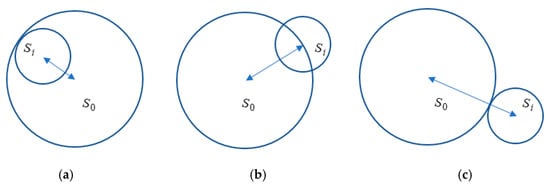
Figure 2.
Quasi-containment : (a) ; (b) ; (c) .
Ratio condition for assures a certain correspondence (proportion) between the number of packed spheres of different radii. Here, is defined as a relative number of spheres of k-th type, (number of packed spheres of k-th type)/(total number of packed spheres), and is a given nonnegative parameter. We distinguish between strict () or non-strict () ratio conditions. The ratio condition is introduced to maintain a certain structure of a particulate matter under different packing configurations. Figure 3 illustrates the ratio condition for spheres of different types (blue, green and yellow 2D spheres in Figure 3). The strict ratio condition is considered with , , . Packing in Figure 3a does not satisfy the ratio condition since . Figure 3b provides a feasible packing that satisfies the ratio condition since .
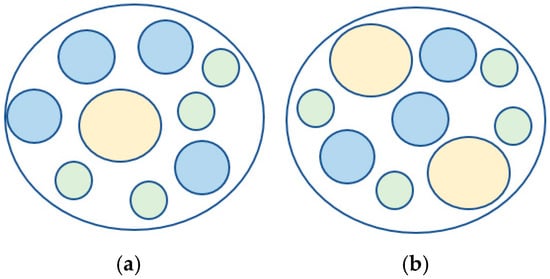
Figure 3.
Ratio condition: (a) infeasible packing and (b) packing that satisfies the ratio condition.
Mixed-Integer Nonlinear Programming Model for RQPS
Let us define the RQPS problem variables. The vector specifies the coordinates of the centers of the spheres , while the vector defines the binary variables.
The vector of all variables is denoted as .
The mathematical model of the RQPS problem has the following form:
subject to
Here,
and inequalities (2) state the quasi-containment conditions, while inequalities (3) represent the partial overlapping conditions for spheres . Constraints (4) state the ratio conditions. Constraints (2) assure that if (quasi-containment condition is not satisfied), then . Constraints (3) guarantee that if (partial overlapping is not satisfied), then and cannot be equal to 1, simultaneously. Note that for , both and satisfy constraint (2). This is similar for the case in (3). However, to maximize the objective (1), must be selected as often as possible. This implies that a solution of model (1)–(4) indeed places the maximal possible number of spheres so that the constraints are satisfied.
The main characteristics of the model (1)–(4) are as follows:
- The model (1)–(4) is a mixed-integer nonlinear mathematical programming problem (MINLP—Mixed-Integer Nonlinear Programming).
- The objective function (1) is linear.
- The total number of variables is ( binary and continuous variables).
- The solution space is defined by + nonlinear constraints of the form (2), (3) and linear inequalities in (4).
If the ratio conditions (4) are omitted (e.g., in case of uniform spheres), then integrality conditions for the variables can be relaxed without losing the optimal solution.
Proposition 1.
Consider the quasi-packing sphere problem (1)–(3) with integrality constraints relaxed to . Then, all optimal solutions to this continuous nonlinear programming problem have only binary components .
Demonstration.
The proof is by contradiction. Suppose that there exists a rational component in the optimal solution. Since , then by (2) we have . Hence, can be increased to 1 without violating constraint (2). If , then by (3) we have and can be increased to 1 without violating constraint (3). For , we can increase to 1 without violating constraint (3) for any sign of . Thus, if , then we can increase to 1 without violating constraints of the problem and thus increase the value of the objective function (1). This contradicts the optimality of .
Packing spheres are known to be NP-hard [1]. Global solvers can find provably optimal solutions to model (1)–(4) for small problem instances with dozens of spheres (see Section 4.1). A heuristic approach below is proposed to find reasonable feasible solutions for larger instances.
3. Heuristic Approach
The main idea of the proposed heuristic algorithm is reducing the original problem to a sequence () of quasi-packing problems of a given number of scaled spheres in a given spherical container. The objective is to maximize the scaling parameter (and, with this, to grow the spheres up to their original size) subject to the ratio conditions.
Let us consider the optimization problem we are going to use in our heuristic algorithm.
To this end, let , , be a given number of scaled spheres, . Let denote a sphere centered at with radius providing
- (a)
- , , ;
- (b)
- and .
Each of the () quasi-packing problems is stated as a nonlinear programming problem:
where is a vector of variables, and the feasible set is described by the following inequality system:
with
Inequality (6) provides the quasi-containment of the scaled sphere in the spherical domain , i.e., , while inequality (7) describes the partial overlapping of scaled spheres and , i.e., .
Let us introduce some notations used in our algorithm. Let denote a minimal set of spheres meeting the ratio condition (4), where: is the cardinality of the set ; denotes an aggregate set of spheres; means a sphere of type .
Our algorithm involves three main stages:
Stage 1. Generation of a minimal set of spheres (minimal block), , that satisfies the strict ratio conditions (Steps 1–7).
Stage 2. Multiple sequential placements of the spheres in meeting the quasi-packing and strict ratio conditions. Creation of an aggregate set (accumulation of blocks) (Steps 8–12).
Stage 3. Placement of additional spheres in the quasi-packing found at Stage 2 meeting the quasi-packing and non-strict ratio conditions (Steps 13–19).
Let us consider the algorithm in detail.
Firstly, an integer specifying the cardinality of the set of spheres is calculated that meets the ratio conditions. Denote assuming (Steps 1–3).
Step 1. Set .
Step 2. Set .
Step 3. If , , then set and go to Step 4; otherwise, go to Step 2. Here, is the floor function.
Then, the minimum index set is formed (Steps 4–7).
Step 4. Set .
Step 5. Set .
Step 6. If , then go to Step 8.
Step 7. Set , and go to Step 6.
Further, the aggregate index set having cardinality and meeting the quasi-packing and the ratio conditions is constructed (Steps 8–10).
Step 8. Set , .
Step 9. Set , .
Step 10. Search for a local maximum of the problem (5)–(8) for the set using a local optimization solver combined with the decomposition procedure. This technique substitutes (approximately) a large-scale nonlinear programming problem with a sequence of considerably smaller nonlinear programming problems with non-overlapping (partially non-overlapping) conditions considering only neighbor spheres. The detailed description of the technique can be found, e.g., in [22,46].
At the next step, we verify the quasi-packing conditions and update the set (Step 11).
Step 11. If , then go to Step 9; otherwise, () set , and go to Step 12.
For the case of the strict ratio conditions, we provide a stopping criterion for our algorithm at Step 12.
Step 12. If , , then stop the algorithm with ; otherwise, go to Step 13.
An addition of single spheres (in a one-by-one scenario) to the set meeting the ratio and quasi-packing conditions is produced at Steps 13–19.
Step 13. Set .
Step 14. Set .
Step 15. If , then set , ; otherwise, stop the algorithm with .
Step 16. If meets (4), then go to Step 17; otherwise, set , and go to Step 14.
Step 17. Search for a local maximum of the problem (5)–(8) for the sphere set . If , then go to Step 18; otherwise, set and stop the algorithm with .
Step 18. If , then set .
Step 19. Go to Step 15.
The flowchart of the algorithm is provided in Figure 4 below.
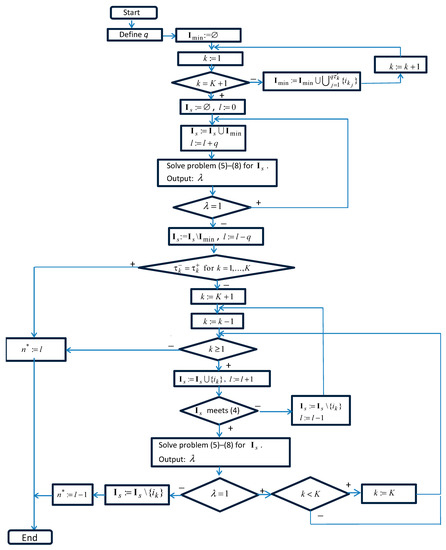
Figure 4.
The flowchart of the main algorithm.
4. Computational Results
To verify the model (1)–(4), the global optimization solver BARON [47,48,49] was used to solve small problem instances. BARON was executed on the NEOS server [50] with AMPL [51] applied for modeling optimization problem (1)–(4). The nonlinear optimization problems (5)–(8) arising in the heuristic algorithm were solved by the local optimization solver IPOPT [52] combined with the decomposition procedure. All computations were executed on Desktop-54TG91N with Intel(R) Core(TM) i3-6100T CPU @ 3.20GHz, RAM 8 Gb.
Three types of instances were used in the computational experiments. In the first case, classical packing problems without violation of non-overlapping and containment conditions (, ) were generated. The second group is composed of packing problems with non-overlapping () and quasi-containment () conditions. In the last group, partial overlapping () and quasi-containment () were permitted. Moreover, strict () and non-strict () ratio conditions (4) were considered.
For each problem, the instance below the maximal number of packed spheres is provided together with the corresponding computation time. For all small problem instances in Section 4.1, global solutions were obtained using BARON, i.e., the optimality-stopping criterion was fulfilled (see [48] for more details). For larger instances in Section 4.2, the best solutions obtained by the heuristic are reported. The value of porosity is also presented. The expression for approximately calculating the porosity can be found in Appendix A.
4.1. Results for Small Instances Using BARON
Example 1.

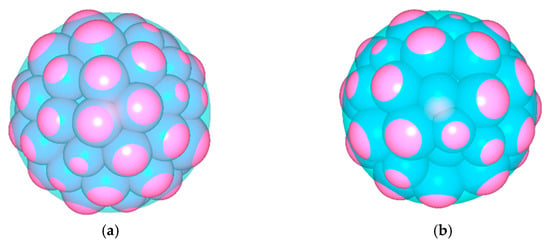
, , . The rest of the input data are given inTable 1. The optimal number of spheres obtained in 222.149 s is ( , ). The value of porosity is 0.18500961206. The corresponding quasi-packing is shown in Figure 5a.

Table 1.
Input data for Examples 1–2.

Figure 5.
Global solutions: (a) Example 1; (b) Example 2.
Example 2.
Example 3.

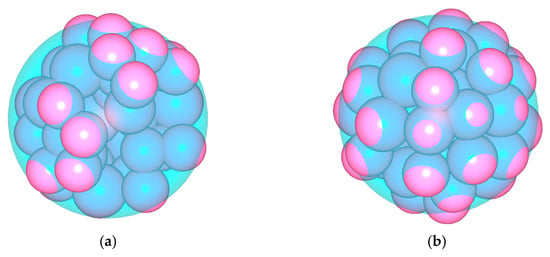
, , . The rest of the input data are given inTable 2. The optimal number of spheres obtained in 98.4785 s is ( ). The value of porosity is 0.40560543556. The corresponding quasi-packing is shown in Figure 6a.

Table 2.
Input data for Examples 3–4.

Figure 6.
Global solutions: (a) Example 3; (b) Example 4.
4.2. Results Obtained by the Heuristic
Example 5.


, , . The rest of the input data are given inTable 3. The number of spheres obtained in 5 s is (, ). The corresponding quasi-packing of 2D spheres is shown in Figure 7a.

Table 3.
Input data for Examples 5 and 6.

Figure 7.
The best solutions: (a) Example 5; (b) Example 6.
Example 6.
Example 7.

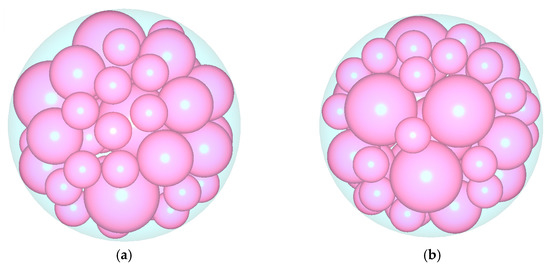
, , . The rest of the input data are given inTable 4. The number of spheres obtained in 5 s is ( ). The value of porosity is 0.504364. The corresponding quasi-packing is shown in Figure 8a.

Table 4.
Input data for Examples 7–20.

Figure 8.
The best solutions: (a) Example 7; (b) Example 8.
Example 8.
Example 9.
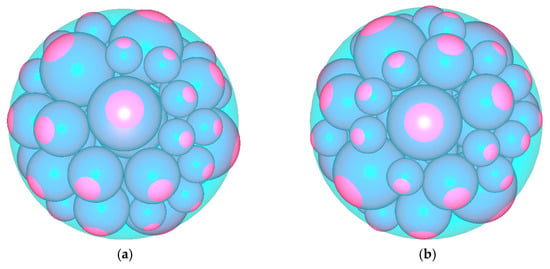
, , . The rest of the input data are given inTable 4. The number of spheres obtained in 5 s is ( ). The value of porosity is 0.433188. The corresponding quasi-packing is shown in Figure 9a.

Figure 9.
The best solutions: (a) Example 9; (b) Example 10.
Example 10.
Example 11.
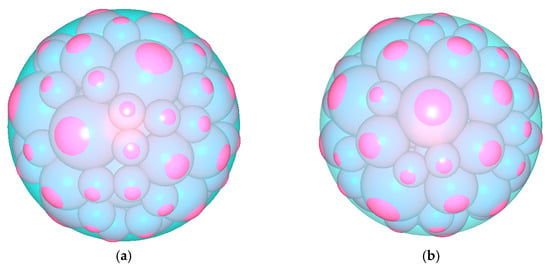
, , . The rest of the input data are specified inTable 4. The number of spheres obtained in 7 s is ( ). The value of porosity is 0.2814923736. The corresponding quasi-packing is shown in Figure 10a.

Figure 10.
The best solutions: (a) Example 11; (b) Example 12.
Example 12.
Example 13.
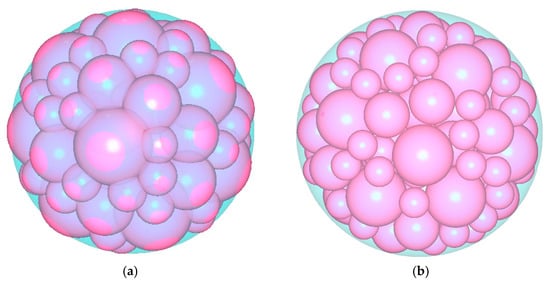
, , . The rest of the input data are given inTable 4. The number of spheres obtained in 20 s is ( ). The value of porosity is 0.155574. The corresponding quasi-packing is shown in Figure 11a.

Figure 11.
The best solutions: (a) Example 13; (b) Example 14.
Example 14.
Example 15.
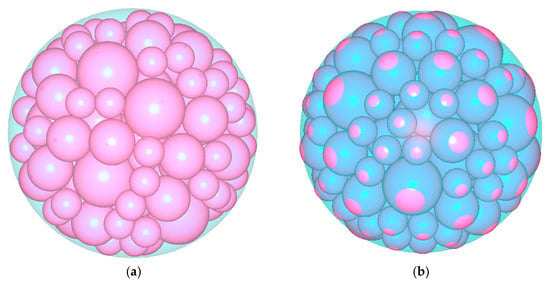
, , . The rest of the input data are given inTable 4. The number of spheres obtained in 14 s is ( ). The value of porosity is 0.438232. The corresponding quasi-packing of spheres is shown in Figure 12a.

Figure 12.
The best solutions: (a) Example 15; (b) Example 16.
Example 16.
Example 17.

, , . The rest of the input data are specified inTable 4. The number of spheres obtained in 18 s is (). The value of porosity is 0.393993. The corresponding spheres are shown inFigure 13a.

Figure 13.
The best solutions: (a) Example 17; (b) Example 18.
Example 18.
Example 19.
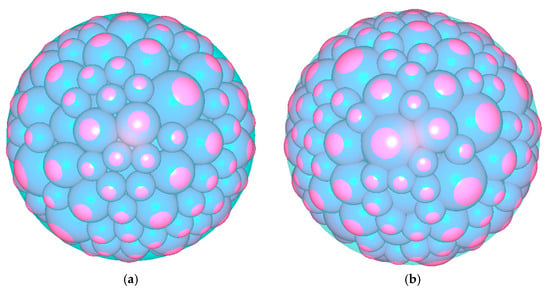
, , . The rest of the input data are specified inTable 4. The number of spheres obtained in 147 s is (). The value of porosity is 0.24759. The corresponding quasi-packing is shown inFigure 14a.

Figure 14.
The best solutions: (a) Example 19; (b) Example 20.
Example 20.
Example 21.

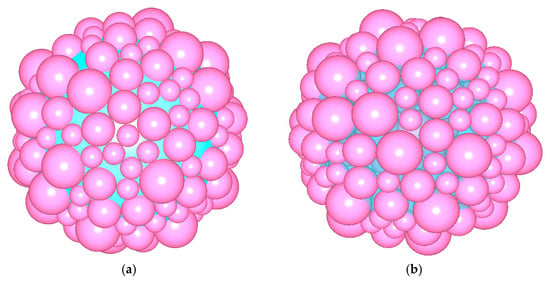
, , . The rest of the input data are given inTable 5. The number of spheres obtained in 68 s is ( ). The value of porosity is 0.244979. The corresponding quasi-packing is shown in Figure 15a. If the number of IPOPT runs is increased, the better value ( ) can be obtained in 230 s with corresponding porosity 0.209132.

Table 5.
Input data for Examples 21–22.

Figure 15.
The best solutions: (a) Example 21; (b) Example 22.
Example 22.
, , . The rest of the input data are given inTable 5. The number of spheres obtained in 412 s is , ( ). The value of porosity is 0.222265. The corresponding quasi-packing is shown in Figure 15b. If the number of IPOPT runs is increased, the better value is obtained in 471 s with corresponding porosity 0.211930.
5. Conclusions
A novel sphere quasi-packing model that allows controlled violation of non-overlapping and containment conditions was developed. Ratio constraints were introduced to establish correspondence between the number of packed spheres of different radii. Corresponding MINLP formulation as well as the heuristic strategy for obtaining good feasible solutions were proposed. Proven optimal global solutions for the MINLP formulation were obtained for small instances with dozens of spheres using the global solver BARON on the NEOS server. For larger instances with hundreds of spheres, the proposed heuristic was successfully implemented providing reasonable feasible solutions. Testing the heuristic for large instances with thousands of spheres is an interesting area for future research. To simplify nonlinear optimization problems, grid approximations [23,24,25,26,53] can be considered to linearize optimized packing problems.
Spherical approximations for particles in porous media are frequently used in material sciences models [8,9,10,11,54,55,56]. However, to make analyses of granular structures more realistic, more sophisticated shapes can be used, e.g., ellipsoids, tetrahedrons, convex polyhedra and their mixtures [57,58]. Mathematical tools for placing convex and irregular non-spherical objects can be found in [59,60,61,62,63,64]. Some results on quasi-packing non-spherical objects are currently being prepared.
Author Contributions
Conceptualization, I.L. and T.R.; methodology, A.F. and P.S.; software, G.Y. and T.R.; validation, G.Y. and T.R.; formal analysis, A.F. and P.S.; investigation, A.F., I.L., T.R., P.S. and G.Y.; resources, P.S. and G.Y.; data curation, G.Y.; writing—original draft preparation, A.F., I.L., T.R., P.S. and G.Y.; writing—review and editing, A.F., I.L., T.R., P.S. and G.Y.; visualization, G.Y.; supervision, A.F., I.L. and T.R.; project administration, I.L. and T.R.; funding acquisition, A.F. and T.R. All authors have read and agreed to the published version of the manuscript.
Funding
This research received no external funding.
Data Availability Statement
The data presented in this study are available on request from the corresponding authors.
Acknowledgments
We would like to thank the anonymous reviewers for their constructive comments, the Volkswagen Foundation (grants No. 97 775 and No. 9C086) and the National Research Foundation of Ukraine (grant No. 02.2020/0128).
Conflicts of Interest
The authors declare no conflict of interest.
Appendix A
Porosity is the percentage of void space in a domain (part of rock, material, soil). It is defined as the ratio of the volume of the void (or pore) space divided by the total volume. Therefore, the exact value of porosity can be defined as
where packing factor is the ratio of the volume of the spheres arranged inside the domain divided by the total volume.
To calculate the exact volume of spheres arranged inside the spherical domain, the inclusion–exclusion principle can be used, which indicates how many elements are in the union of a finite number of spheres.
Let be a finite set of spheres; then,
Due to small values of used in the computational experiments, only pairwise intersections of spheres are taken into account. That is, volumes of the intersections of more than two spheres are ignored, starting with volumes of intersections of the triples of spheres for .
To calculate an approximate porosity in Section 4, the following formula is used:
where is the volume of , is the volume of , is the volume of .
In particular, is defined (see, e.g., https://mathworld.wolfram.com/Sphere-SphereIntersection.html, accessed on 14 January 2023) as
where
is the spherical cap of cut off by the plane (Figure A1), is the spherical cap of cut off by , is a sphere with center and radius , is a sphere with center and radius , is the plane providing , is the distance between the centers and . Volume is calculated similarly.
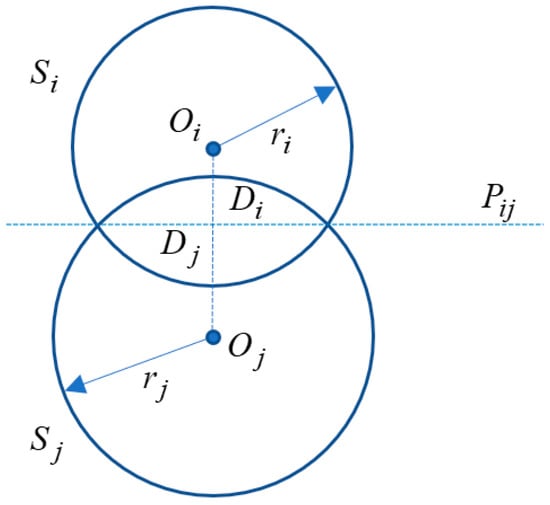
Figure A1.
Spherical caps and .
If exact values of intersections are calculated, then the packing factor increases and the porosity decreases. Correspondingly, the approximate value of the porosity calculated in (A2) provides an upper bound for the exact value.
References
- Hifi, M.; M’Hallah, R. A literature review on circle and sphere packing problems: Models and methodologies. Adv. Oper. Res. 2009, 2009, 150624. [Google Scholar] [CrossRef]
- Cremer, T.; Cremer, M. Chromosome territories. Cold Spring Harb. Perspect. Biol. 2010, 2, a003889. [Google Scholar] [CrossRef] [PubMed]
- Raj, A.; Chen, Y.-H. The wiring economy principle: Connectivity determines anatomy in the human brain. PLoS ONE 2011, 6, e14832. [Google Scholar] [CrossRef] [PubMed]
- Rivera-Alba, M.; Vitaladevuni, S.N.; Mishchenko, Y.; Lu, Z.; Takemura, S.-Y.; Scheffer, L.; Meinertzhagen, I.A.; Chklovskii, D.B.; de Polavieja, G.G. Wiring economy and volume exclusion determine neuronal placement in the Drosophila brain. Curr. Biol. 2011, 21, 2000–2005. [Google Scholar] [CrossRef] [PubMed]
- Karklin, Y.; Simoncelli, E.P. Efficient coding of natural images with a population of noisy Linear-Nonlinear neurons. Adv. Neural Inf. Process. Syst. 2011, 24, 999–1007. [Google Scholar]
- Sutou, A.; Day, Y. Global optimization approach to unequal sphere packing problems in 3D. J. Optim. Theory Appl. 2002, 114, 671–694. [Google Scholar] [CrossRef]
- Wang, J. Packing of unequal spheres and automated radiosurgical treatment planning. J. Combin. Optim. 1999, 3, 453–463. [Google Scholar] [CrossRef]
- Burtseva, L.; Pestryakov, A.; Romero, R.; Valdez, B.; Petranovskii, V. Some aspects of computer approaches to simulation of bimodal sphere packing in material engineering. Adv. Mater. Res. 2014, 1040, 585–591. [Google Scholar] [CrossRef]
- Duriagina, Z.; Lemishka, I.; Litvinchev, I.; Marmolejo, J.A.; Pankratov, A.; Romanova, T.; Yaskov, G. Optimized filling of a given cuboid with spherical powders for additive manufacturing. J. Oper. Res. Soc. China 2021, 9, 853–868. [Google Scholar] [CrossRef]
- Frenkel, D. Computer simulation of hard-core models for liquid crystals. Mol. Phys. 1987, 60, 1–20. [Google Scholar] [CrossRef]
- Yamada, S.; Kanno, J.; Miyauchi, M. Multi-sized sphere packing in containers: Optimization formula for obtaining the highest density with two different sized spheres. IPSJ Online Trans. 2011, 4, 126–133. [Google Scholar] [CrossRef]
- Araujo, L.J.P.; Ozcan, E.; Atkin, J.A.D.; Baumers, M. Analysis of irregular three-dimensional packing problems in additive manufacturing: A new taxonomy and dataset. Intern. J. Prod. Res. 2019, 57, 5920–5934. [Google Scholar] [CrossRef]
- Romanova, T.; Stoyan, Y.; Pankratov, A.; Litvinchev, I.; Yanchevsky, I.; Mozgova, I. Optimal Packing in Additive Manufacturing. IFAC-PapersOnLine 2019, 52, 2758–2763. [Google Scholar] [CrossRef]
- Romanova, T.; Stoyan, Y.; Pankratov, A.; Litvinchev, I.; Avramov, K.; Chernobryvko, M.; Yanchevskyi, I. Optimal layout of ellipses and its application for additive manufacturing. Int. J. Prod. Res. 2021, 59, 560–575. [Google Scholar] [CrossRef]
- Halkarni, S.S.; Sridharan, A.; Prabhu, S.V. Experimental investigation on effect of random packing with uniform sized spheres inside concentric tube heat exchangers on heat transfer coefficient and using water as working medium. Int. J. Therm. Sci. 2018, 133, 341–356. [Google Scholar] [CrossRef]
- Mueller, G.E. Numerically packing spheres in cylinders. Powder Technol. 2005, 159, 105–110. [Google Scholar] [CrossRef]
- Flaischlen, S.; Wehinger, G.D. Synthetic packed-bed generation for CFD simulations: Blender vs. STAR-CCM+. ChemEngineering 2019, 3, 52. [Google Scholar] [CrossRef]
- Castillo, I.; Kampas, F.J.; Pintér, J.D. Solving circle packing problems by global optimization: Numerical results and industrial applications. Eur. J. Oper. Res. 2008, 191, 786–802. [Google Scholar] [CrossRef]
- Miyazawa, F.K.; Wakabayashi, Y. Techniques and results on approximation algorithms for packing circles. São Paulo J. Math. Sci. 2022, 16, 585–615. [Google Scholar] [CrossRef]
- Martinez, L.; Andrade, R.; Birgin, E.G.; Martinez, J.M. Packmol: A package for building initial configurations for molecular dynamics simulations. J. Comput. Chem. 2009, 30, 2157–2164. [Google Scholar] [CrossRef]
- Amore, P. Circle packing in regular polygons. Phys. Fluids 2023, 35, 027130. [Google Scholar] [CrossRef]
- Stoyan, Y.; Yaskov, G.; Romanova, T.; Litvinchev, I.; Yakovlev, S.; Cantu, J.M.V. Optimized packing multidimensional hyperspheres: A unified approach. Math. Biosci. Eng. 2020, 17, 6601–6630. [Google Scholar] [CrossRef] [PubMed]
- Toledo, F.M.B.; Carravilla, M.A.; Ribeiro, C.; Oliveira, J.F.; Gomes, A.M. The dotted-board model: A new MIP model for nesting irregular shapes. Int. J. Prod. Econ. 2013, 145, 478–487. [Google Scholar] [CrossRef]
- Galiev, S.I.; Lisafina, M.S. Linear models for the approximate solution of the problem of packing equal circles into a given domain. Eur. J. Oper. Res. 2013, 230, 505–514. [Google Scholar] [CrossRef]
- Litvinchev, I.; Infante, L.; Ozuna Espinosa, E.L. Approximate Circle Packing in a Rectangular Container: Integer Programming Formulations and Valid Inequalities. In Computational Logistics. ICCL 2014; Lecture Notes in Computer Science; González-Ramírez, R.G., Schulte, F., Voß, S., Ceroni Díaz, J.A., Eds.; Springer: Cham, Switzerland, 2014; Volume 8760, pp. 47–60. [Google Scholar] [CrossRef]
- Litvinchev, I.; Ozuna, E.L. Integer programming formulations for approximate packing circles in a rectangular container. Math. Probl. Eng. 2014, 2014, 317697. [Google Scholar] [CrossRef]
- He, K.; Tole, K.; Ni, F.; Yuan, Y.; Liao, L. Adaptive large neighborhood search for solving the circle bin packing problem. Comput. Oper. Res. 2021, 127, 105140. [Google Scholar] [CrossRef]
- Yuan, Y.; Tole, K.; Ni, F.; He, K.; Xiong, Z.; Liu, J. Adaptive simulated annealing with greedy search for the circle bin packing problem. Comput. Oper. Res. 2022, 144, 105826. [Google Scholar] [CrossRef]
- Morales, A.; Fierrez, J.; Acien, A.; Tolosana, R.; Serna, I. SetMargin loss applied to deep keystroke biometrics with circle packing interpretation. Pattern Recognit. 2022, 122, 108283. [Google Scholar] [CrossRef]
- Lai, X.; Hao, J.K.; Yue, D.; Lü, Z.; Fu, Z.H. Iterated dynamic thresholding search for packing equal circles into a circular container. Eur. J. Oper. Res. 2022, 299, 137–153. [Google Scholar] [CrossRef]
- von Seckendorff, J.; Achterhold, K.; Pfeiffer, F.; Fischer, R.; Hinrichsen, O. Experimental and numerical analysis of void structure in random packed beds of spheres. Powder Technol. 2021, 380, 613–628. [Google Scholar] [CrossRef]
- Hifi, M.; Yousef, L. A local search-based method for sphere packing problems. Eur. J. Oper. Res. 2019, 274, 482–500. [Google Scholar] [CrossRef]
- Hifi, M.; Youssouf, A.M.; Yousef, L.A. Population-Based Algorithm for the Sphere Packing Problem. In Proceedings of the 2022 8th International Conference on Control, Decision and Information Technologies (CoDIT), Istanbul, Turkey, 17 May 2022; Volume 1, pp. 1455–1460. [Google Scholar]
- Uhler, C.; Wright, S.J. Packing ellipsoids with overlap. SIAM Rev. 2013, 55, 671–706. [Google Scholar] [CrossRef][Green Version]
- DeVries, S.H.; Baylor, D.A. Mosaic arrangement of ganglion cell receptive fields in rabbit retina. J. Neurophysiol. 1997, 78, 2048–2060. [Google Scholar] [CrossRef]
- McDonnell, M.D.; Stocks, N.G. Maximally informative stimuli and tuning curves for sigmoidal Rate-Coding neurons and populations. Phys. Rev. Lett. 2008, 101, 058103. [Google Scholar] [CrossRef]
- Iglesias-Ham, M.; Kerber, M.; Uhler, C. Sphere Packing with Limited Overlap. In Proceedings of the 26th Canadian Conference on Computational Geometry, CCCG 2014, Halifax, NS, Canada, 11–13 August 2014. [Google Scholar]
- Blunt, M.J. Multiphase Flow in Permeable Media: A Pore-Scale Perspective; Cambridge University Press: Cambridge, UK, 2017; p. 500. [Google Scholar] [CrossRef]
- Gerke, K.M.; Korost, D.V.; Karsanina, M.V.; Korost, S.P.; Vasiliev, R.V.; Lavrukhin, V.R.; Gafurova, D.R. Modern approaches to pore space scale digital modeling of core structure and multiphase flow. Georesursy 2021, 23, 197–213. [Google Scholar] [CrossRef]
- Sedaghat, M.H.; Gerke, K.; Azizmohammadi, S.; Matthai, S.K. Simulation-based determination of relative permeability in laminated rocks. Energy Procedia 2016, 97, 433–439. [Google Scholar] [CrossRef][Green Version]
- Eichheimer, P.; Thielmann, M.; Popov, A.; Golabek, G.J.; Fujita, W.; Kottwitz, M.O.; Kaus, B.J.P. Pore-scale permeability prediction for Newtonian and non-Newtonian fluids. Solid Earth 2019, 10, 1717–1731. [Google Scholar] [CrossRef]
- Dong, X.; Liu, H.; Hou, J.; Zhang, Z.; Chen, Z. Multi-thermal fluid assisted gravity drainage process: A new improved-oil-recovery technique for thick heavy oil reservoir. J. Pet. Sci. Eng. 2015, 133, 1–11. [Google Scholar] [CrossRef]
- Al-Nakhli, A.; Tariq, Z.; Mahmoud, M.; Abdulraheem, A.; Al-Shehri, D. A Novel Thermochemical Fracturing Approach to Reduce Fracturing Pressure of High Strength Rocks. In Proceedings of the Abu Dhabi International Petroleum Exhibition & Conference, SPE-197593-MS, Abu Dhabi, United Arab Emirates, 11–14 November 2019. [Google Scholar] [CrossRef]
- Duriagina, Z.A.; Lemishka, I.A.; Trostianchyn, A.M.; Kulyk, V.V.; Svachko, S.G.; Tepla, T.L.; Pleshakov, E.I.; Kovbasyuk, T.M. The effect of morphology and particle-size distribution of VT20 titanium alloy powders on the mechanical properties of deposited coatings. Powder Metall. Met. Ceram. 2019, 57, 697–702. [Google Scholar] [CrossRef]
- Ning, J.; Wang, W.; Zamorano, B.; Liang, S.Y. Analytical modeling of lack-of-fusion porosity in metal additive manufacturing. Appl. Phys. A 2019, 125, 797. [Google Scholar] [CrossRef]
- Romanova, T.; Stoyan, Y.; Pankratov, A.; Litvinchev, I.; Marmolejo, J.A. Decomposition Algorithm for Irregular Placement Problems. In Intelligent Computing and Optimization ICO 2019; Advances in Intelligent Systems and Computing; Vasant, P., Zelinka, I., Weber, G.W., Eds.; Springer: Cham, Switzerland, 2020; Volume 1072, pp. 214–221. [Google Scholar]
- Kilinc, M.R.; Sahinidis, N.V. Exploiting integrality in the global optimization of mixed integer nonlinear programming problems with BARON. Optim. Methods Softw. 2018, 33, 540–562. [Google Scholar] [CrossRef]
- Sahinidis, N. BARON User Manual V. Available online: http://www.minlp.com/downloads/docs/baronmanual.pdf (accessed on 3 November 2022).
- Tawarmalani, M.; Sahinidis, N.V. A polyhedral branch-and-cut approach to global optimization. Math. Program. 2005, 103, 225–249. [Google Scholar] [CrossRef]
- NEOS Server: State-of-the-Art Solvers for Numerical Optimization. Available online: https://neos-server.org/neos/ (accessed on 11 January 2023).
- Fourer, R.; Gay, D.M.; Kernighan, B.W. AMPL: A Modeling Language for Mathematical Programming, 2nd ed.; Thomson Learning: Chicago, IL, USA, 2002. [Google Scholar]
- IPOPT: Documentation. Available online: https://coin-or.github.io/Ipopt/ (accessed on 14 January 2023).
- Litvinchev, I.; Ozuna, E.L. Approximate packing circles in a rectangular container: Valid inequalities and nesting. J. Appl. Res. Technol. 2014, 12, 716–723. [Google Scholar] [CrossRef]
- Michaelis, A.; Scheithauer, U.; Moritz, T.; Weingarten, S.; Abel, J.; Schwarzer, E.; Kunz, W. Advanced Manufacturing for Advanced Ceramics. Procedia CIRP 2020, 95, 18–22. [Google Scholar] [CrossRef]
- Abel, J.; Scheithauer, U.; Janics, T.; Hampel, S.; Cano, S.; Müller-Köhn, A.; Günther, A.; Kukla, C.; Moritz, T. Fused Filament Fabrication (FFF) of Metal-Ceramic Components. J. Vis. Exp. 2018, 143, e57693. [Google Scholar]
- Stoyan, Y.G.; Romanova, T.E.; Pankratov, O.V.; Stetsyuk, P.I.; Stoyan, Y.E. Sparse balanced layout of spherical voids in three-dimensional domains. Cybern. Syst. Anal. 2021, 57, 542–551. [Google Scholar] [CrossRef]
- Zhao, B.; An, X.; Wang, Y.; Zhao, H.; Shen, L.; Sun, X.; Zou, R. Packing of different shaped tetrahedral particles: DEM simulation and experimental study. Powder Technol. 2020, 360, 21–32. [Google Scholar] [CrossRef]
- Zhao, B.; An, X.; Zhao, H.; Gou, D.; Shen, L.; Sun, X. DEM simulation on random packings of binary tetrahedron-sphere mixtures. Powder Technol. 2020, 361, 160–170. [Google Scholar] [CrossRef]
- Stoyan, Y.; Pankratov, A.; Romanova, T. Placement Problems for Irregular Objects: Mathematical Modeling, Optimization and Applications. In Optimization Methods and Applications; Springer Optimization and Its Applications, Butenko, S., Pardalos, P., Shylo, V., Eds.; Springer: Cham, Switzerland, 2017; Volume 130, pp. 521–559. [Google Scholar] [CrossRef]
- Stoyan, Y.; Pankratov, A.; Romanova, T.; Fasano, G.; Pintér, J.D.; Stoian, Y.E.; Chugay, A. Optimized Packings in Space Engineering Applications: Part I Modeling and Optimization in Space Engineering; Springer Optimization and Its Applications, Fasano, G., Pintér, J., Eds.; Springer: Cham, Switzerland, 2019; Volume 144, pp. 395–437. [Google Scholar] [CrossRef]
- Pankratov, A.; Romanova, T.; Litvinchev, I. Packing ellipses in an optimized convex polygon. J. Glob. Optim. 2019, 75, 495–522. [Google Scholar] [CrossRef]
- Romanova, T.; Litvinchev, I.; Pankratov, A. Packing ellipsoids in an optimized cylinder. Eur. J. Oper. Res. 2020, 285, 429–443. [Google Scholar] [CrossRef]
- Romanova, T.E.; Stetsyuk, P.I.; Chugay, A.M.; Shekhovtsov, S.B. Parallel computing technologies for solving optimization problems of geometric design. Cybern. Syst. Anal. 2019, 55, 894–904. [Google Scholar] [CrossRef]
- Stoyan, Y.G.; Romanova, T.E.; Pankratov, O.V.; Stetsyuk, P.I.; Maksimov, S.V. Sparse balanced layout of ellipsoids. Cybern. Syst. Anal. 2021, 57, 864–873. [Google Scholar] [CrossRef]
Disclaimer/Publisher’s Note: The statements, opinions and data contained in all publications are solely those of the individual author(s) and contributor(s) and not of MDPI and/or the editor(s). MDPI and/or the editor(s) disclaim responsibility for any injury to people or property resulting from any ideas, methods, instructions or products referred to in the content. |
© 2023 by the authors. Licensee MDPI, Basel, Switzerland. This article is an open access article distributed under the terms and conditions of the Creative Commons Attribution (CC BY) license (https://creativecommons.org/licenses/by/4.0/).